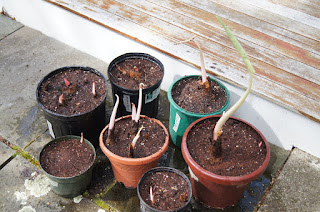I apologize for infrequent posts. I’m absorbed with a happy event, my son’s wedding next weekend. I’ll be back with another post in June. Here’s something I hope you’ll enjoy for the end of May:
White flowers signify innocence, purity, honesty, perfection--and weddings. Whatever the occasion, May’s white flowers are especially beautiful.
Before we assume that flowers are white for a biological purpose, we have to bear in mind that from the plant’s point of view, human vision is beside the point. Flowers evolve mostly to attract pollinators.
Bee vision, for example, differs from ours. Bees can’t see at the red end of the visible light spectrum, but they see ultraviolet light that’s invisible to us. A flower that looks white to us could show a bee ultraviolet runway stripes (nectar guides) or bullseyes to mark the landing area, holding up a sign that says “Get your nectar and pollen here!”
 |
| Visible nectar guides--stripes on this iris--guide bumblebees to pollen. Photo by Al Schneider |
Each of my white flowers has a different strategy for getting its flowers pollinated and reproducing itself.
Sweet woodruff (Galium odoratum) is a hermaphrodite pollinated by bees, flies, or itself—no wonder it spreads so fast.
Double-file viburnum (Viburnum plicatum var. tomentosum ‘Shasta’) has been fooling visitors this spring into thinking it’s a dogwood because of its horizontal rows of glowing white flowers. These attract insects and humans first with larger, sterile flowers that resemble the “petals” on flowering dogwoods (in fact those are adapted leaves called bracts).
The inner fertile flowers of the viburnum open a few days later.
Lily-of-the-valley (Convallaria majalis) is flowering profusely this week. Last year must have been a good one for this plant, because as its leaves emerge this spring, I’m finding it has expanded into new territory. The tiny bells on its flower stalks are pollinated by honeybees and bumblebees.
Each lily-of-the valley needs to cross with a genetically distinct plant to make fruit, one red berry per plant. But anyone who lives with this determined shade grower knows it does plenty of vegetative spreading even without fruit.
The flowers of dwarf fothergilla (Fothergilla gardenii) have both male and female parts but no petals. I read that they’re pollinated by honeybees. Offering such easy access to nectar, they must attract other insects too.
 |
| Bottlebrush flowers of dwarf fothergilla |
Bleeding heart, a member of the poppy family (Papaveraceae), offers pollen but not nectar to visiting insects.
 |
| White bleeding heart, Dicentra spectabilis 'Alba' |
Once the seed develops, bleeding heart has an interesting method for spreading it around. Each seed is attached to an elaiosome, a white fleshy blob rich in lipids that ants like to eat.
 |
| Bleeding heart seeds with attached elaiosomes |
Ants carry the seed back to their anthills and eat the elaiosome without damaging the seed. In return, the seed gets a free ride to a location farther from its parent plant than it could otherwise travel.













